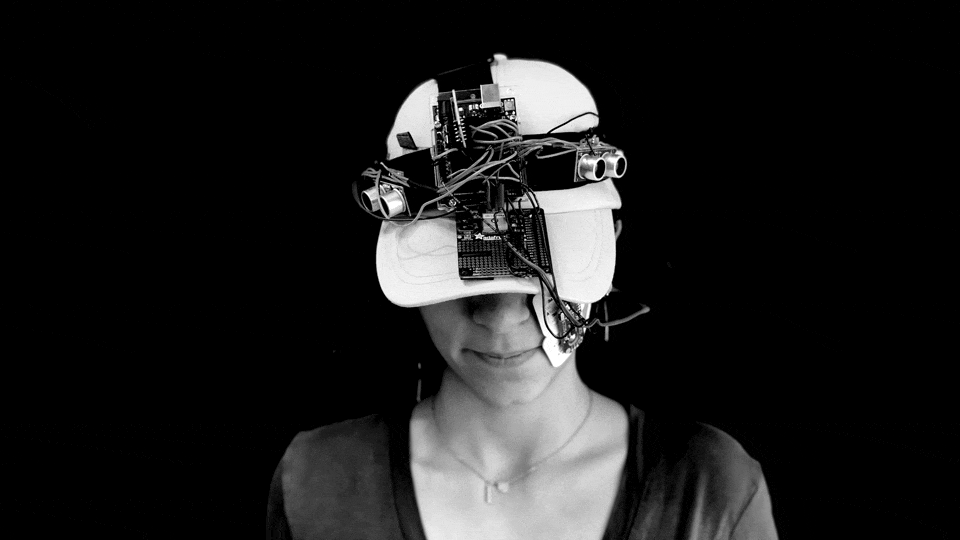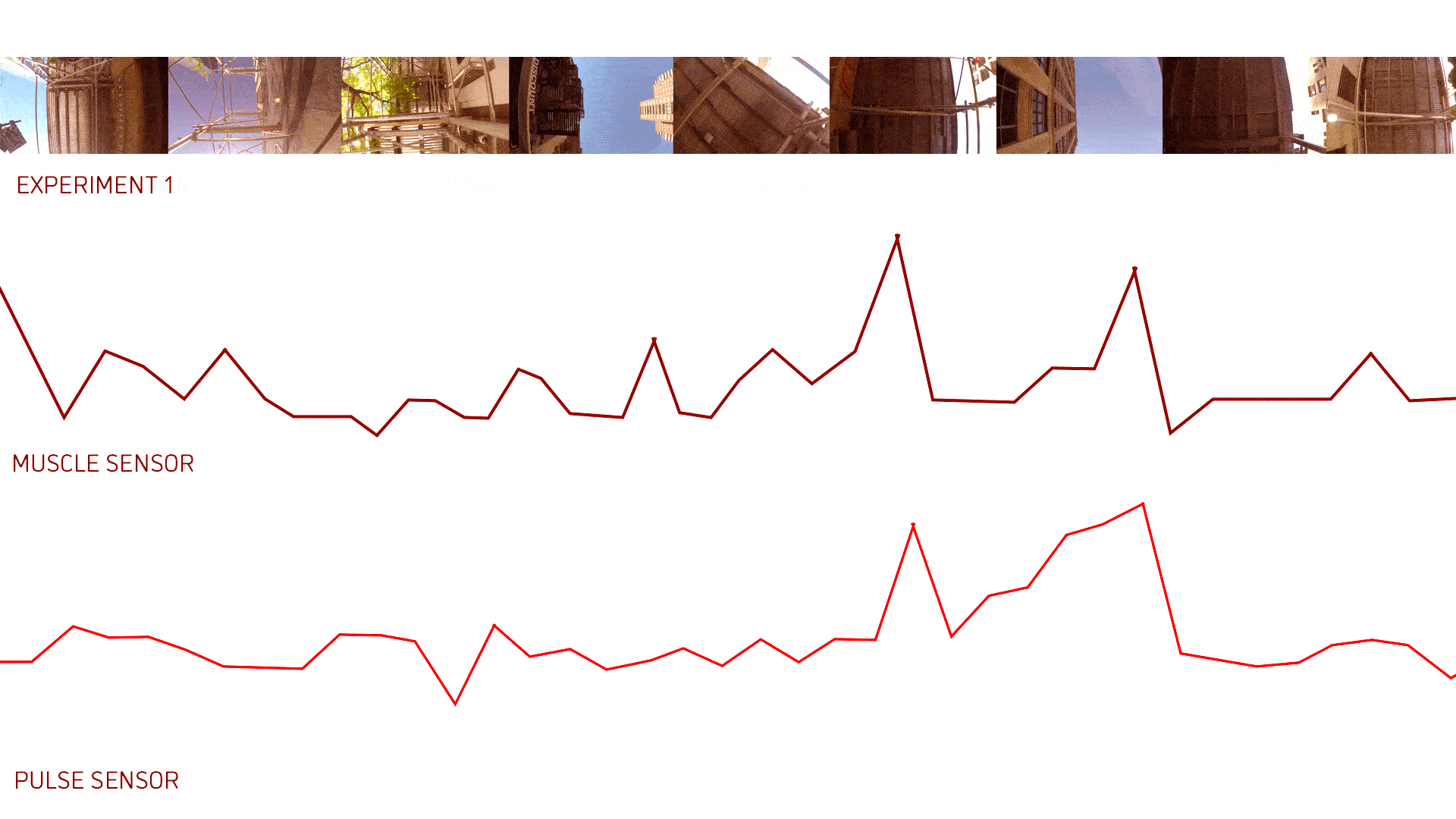This project is hosted on my older website.
For my latest (still-in-progress) work, visit www.karenasmar.com.
Research Citizen Science —
Bodies (as Sensors) in Cities
Augmenting Design Research Methods (Part I) & Body Responses to City Infrastructure (Part II)
PART I
C: How might we augment design research methods to better understand the impact of the built environment on our state of mind?
S: By using technology as a mediator between the individual and the built environment, I created a research tool to collect my body responses as I walk in the city of New York, specifically under scaffoldings.
PART II
C: What if the built environment was able to recognize our emotions and respond to us in real-time?
S: The second part explores the notion of “city as a personal assistant” and dives into the implications of the expanding device ecology and the notion of the quantified self in “smart” cities.
CONTEXT
Parsons School of Design
Mar. '19 - Apr. '19
TAGS
Human-Space Interaction,
Body as Interface,
Decision-Making,
Citizen Science,
Data Visualization
ROLE
Independent Project,
Research, Experiment,
Prototype & Design
Problem Space —
Research01 *
Walking down the streets of New York City, there is one thing one could almost never miss: sidewalk sheds. As of April 2019, the streets of NYC are lined up with a total of 8,489 active sidewalk sheds which are associated with construction-related activities.
The NYC Department of Building recently provided an interactive map that allows people to track every scaffold in New York and learn about several factors that characterize its presence - notably, the scaffold’s age, size, date of implementation and date of expiration.
Sidewalk Sheds Interactive Map
Problem Enforced by Law
Based on Local Law 11, every five years, every building in NYC must submit a documentation regarding the conditions of its facade to the Department of Buildings. If regarded as unsafe, landlords are required to put up a sidewalk shed. This law, however, does not state when landlords are required to remove these sheds which often leads to an indefinite existence of these sheds.
Scaffolds are part of our everyday built environment and our built environment affects and shapes the way we think, feel, and behave.
Identifying Opportunity —
Approach02 *
Design Criteria
Part 1 Augmenting Design Research Methods
PROBLEM
A variety of parameters attempt to capture characteristics of places, yet, these elements do not depict the qualitative aspects that constitute the real experiential character of built environments.
APPROACH
By focusing on effects of scaffolds on our emotions as a case study, I combined objective quantification (analysis) with subjective perception (experience) to research the way we experience the built environment and to explore the role of digital tools in understanding urban qualities.
Part 2 Augmenting Body Responses to Cities
APPROACH
After analyzing the results of the first experiment, I propose an augmented tool that aims to reverse the negative effects of scaffolds by triggering people's faces to smile every time they are under one.
REFLECTION
The approach is satirical and imagines a world where it is easier to augment humans than to fix the urban environment. The goal aim is also to ultimately improve the daily lives of citizens in ways beyond the efficiency and optimization-driven approaches widely employed by technology’s advocates.
Design Questions (Part I)
Design Questions (Part II)
01
How does the built environment impact our state of mind?
01
How can technology improve our human experience in a city and enhance our relationship with the built environments we are in?
02
How might we augment design research methods to better understand the impact of the built environment on our inner states?
02
What if the built environment was able to recognize our emotions and respond to us in real-time?
Augmenting Design Research Methods —
Part 103 *
Experiment 1 Setup
01 Identifying Parameters
First, I Identify the parameters of the shed by dissecting it into its main elements: its form, physical occupation, activity, bounding space, illumination technique and materiality.
02 Physiological Parameters & Sensors
The sensors chosen are based on Edward T. Hall’s proxemics theory that identify 4 main spaces around the human body: the intimate space, the personal space, the social space and the public space. For each space, I use a sensor that can sense a characteristic of this space.
Through this approach, I aim to study the relationship between the inner state of the body and its, gradually increasing, wider urban context.
03 Augmented Design Research Tool
The tool takes the form of a “hacked” common everyday object: a hat.
04 The Path
Based on data from NYC Sidewalk Sheds map, I designed a path that goes through the most amount of scaffolds while crossing through some of the city’s “multiple personalities”:
- It starts at 34th street - a central transportation hub,
- goes through Hudson Yards - referred to as “the smart city experiment”
- through Chelsea - a bourgeois neighborhood
- finishes on 16th Street, Greenwich Village.
05 Experiment 1 Video
06 Results
After collecting the data, I visualized it using Grasshopper.
The result reveals my journey as a visual track on a map:
- height of bars indicate my heart rate and my muscle tension at a particular moment,
- the circles reveal the proximity of people around me at certain moments in time.
Results from Sensors (Saved to CSV file in SD Card)
Visualizing Results from CSV Files
City Opportunities
This research method explores how built environment can impact our physiological and psychological spaces. By adopting a multisensory and multidisciplinary approach, it is possible to gain a more human-centered and perhaps unexplored understanding of human experience in a city to be able to better design it.
Merging subjective and objective data from people in a city could present us with a bottom-up process of identifying communal matters of concern and setting ground for a new approach to city planning and problem solving.
Augmenting Experiences —
Part 204 *
After analyzing and reflecting on the results of experiment 1, I asked the following questions:
- What happens when the sensors on our bodies become connected to city infrastructure?
- What happens when the city gains the ability to see and act as if it has eyes and a body?
By mapping GPS location of scaffolding to human facial muscle stimulation, I propose a device to improve the overall street experience of individuals. I focus on electrophysiology as a technique to technologically augment human body responses to sidewalk sheds in the built environment.
Future of Cities-Citizen Relationship
Today's technologies will allow spaces of tomorrow to be formed from interconnected and intelligent components that are aware of human presence and able to communicate, assess and act.
Citizens are also rapidly adopting new wearable technologies that are more intimate than previous technologies.
Human-Space Interface
I explore electrophysiology* as a technique for an interface with the built environment aimed to improve human experiences in cities.
*Electrophysiology is the study of the electrical properties of biological cells and tissues. Innovations in this area have illustrated ways of how people can control many things using their biosignals. In this project I propose the reverse idea of how human body parts can be controlled by others or even by computers to psychologically affect emotions.
Experiment 2 Setup
01 The Form
The design takes the form of an accessory that can be wrapped around the waist. It is reminiscent of the walkman devices people used to carry around in 1980-2000s.
Electrode wires come out of the device and are placed on the face, similar to the way earphones and headphones came out of these earlier devices.
03 Tool Components
- TENS Unit (a device that delivers small electrical impulses through electrodes)
- Electrodes
- Muscle Sensor
- GPS Module
04 How it Works
GPS & Dataset Results
05 Main Purpose
The purpose is to reverse and trick the mind to be in a positive state and “re-balance” a person’s inner state.
06 Experiment 2 Video
07 Results
The result reveals my journey as a visual track on a map:
- height indicates my muscle tension at a particular moment in time in a specific location.
Thoughts & People's Reactions —
Reflection05 *
This project acts as an example of a larger domain area of human-space interactions, human-data interaction and space-data interactions.
I believe that such experiments open up an opportunity and possibility to start designing such relationships to foster and enhance the relationship of humans with their cities, buildings and built environments.
Some Reactions of Passersby During the Experiments































